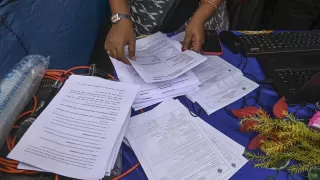The Indira Gandhi International Airport (IGIA) in Delhi, one of the busiest aviation hubs in the world, faced massive disruptions on Friday after a major technical glitch affected hundreds of flights. Handling over 1,500 flight movements daily, the airport witnessed over 800 flight delays and at least 20 cancellations, causing inconvenience to thousands of passengers. The issue, which originated in the airport’s Automatic Message Switching System (AMSS), led to a temporary breakdown in communication with the Air Traffic Control (ATC) flight planning system.
By Saturday morning, Delhi Airport officials confirmed that the situation was “gradually improving” as technical teams worked around the clock to restore full functionality. Airlines also began reporting improvements in operations, with flights taking off and landing closer to schedule. Authorities emphasized that while the glitch had significantly disrupted air travel across India, the system was stabilizing and flight operations were returning to normalcy.
Passengers were advised to stay in touch with their respective airlines for the latest updates on departure and arrival times. Many travelers who faced overnight delays expressed relief as operations began to normalize, although residual effects continued to impact schedules through the weekend. The airport management has assured the public that measures are being taken to prevent such incidents in the future.
Delhi Airport’s Technical Glitch: What Went Wrong?
The glitch was traced to a malfunction in the Automatic Message Switching System (AMSS), a key digital infrastructure that facilitates communication between flight operators and the Air Traffic Control (ATC). This system handles real-time data related to flight plans, routing, and coordination across airspaces. When it malfunctioned, flight plans could not be processed automatically, forcing staff to manually input data—a time-consuming process that resulted in large-scale delays.
According to initial reports, the issue began in the IP-based AMSS system managed by the Airports Authority of India (AAI). Engineers and technical experts from the Electronics Corporation of India Limited (ECIL) were immediately deployed to address the malfunction. While the system was restored late Friday evening, backlogs caused lingering disruptions in normal operations well into Saturday morning.
Impact on Air Travel Across India
The disruption at Delhi’s Terminal 3, which manages most of the country’s international and domestic air traffic, had a cascading effect on airports across India. Cities such as Mumbai, Bengaluru, Jaipur, and Lucknow also experienced knock-on delays as aircraft rotation schedules were affected. Airlines had to reschedule numerous flights, and passengers were asked to arrive at airports early to manage boarding and check-in delays.
More than 800 flights were delayed, with some waiting for over two hours for takeoff clearance. Airlines like IndiGo, Air India, Vistara, and SpiceJet issued advisories to passengers regarding expected delays and requested cooperation as the airport authorities worked to stabilize the system. Several airlines reported temporary suspension of boarding processes during the peak of the outage to ensure passenger safety and accurate data synchronization.
Efforts to Restore Normalcy at Delhi Airport
The Delhi Airport operations team, in coordination with the AAI and ECIL, initiated an immediate technical review to restore the affected systems. The original equipment manufacturer (OEM) was also engaged to identify and rectify the source of the malfunction. The airport’s statement noted that additional staff were deployed to manually process flight plans during the downtime to ensure uninterrupted and safe air traffic operations.
By early Saturday morning, the AAI confirmed that the AMSS systems were up and running. However, they warned that due to the accumulated backlog, minor delays could still occur until full synchronization of automated systems was completed. Passengers were advised to continue monitoring their flight statuses online and through official airline updates.
Response from Airlines and Authorities
Following Delhi Airport’s update, several airlines, including IndiGo, acknowledged that they were working closely with the airport operator and ATC teams to stabilize operations. IndiGo stated that while most systems had been restored, flight timings would continue to be adjusted until normal patterns resumed. Air India also informed passengers that its technical and ground staff were assisting travelers affected by the disruption.
The Airports Authority of India reiterated that safety remained their top priority during the manual handling phase. Officials emphasized that while such incidents are rare, they highlight the need for stronger backup mechanisms and real-time monitoring systems to prevent future occurrences.
Role of the Automatic Message Switching System (AMSS)
The AMSS is a critical digital communication system that supports air traffic control by managing and transmitting flight plans, NOTAMs (Notices to Airmen), and meteorological information. It ensures smooth coordination between various flight control centers across regions. Any disruption in this system can result in data delays, forcing controllers to resort to manual operations, which significantly slows down flight scheduling and clearance.
Experts believe the glitch in the AMSS could have been caused by a network failure or software malfunction. While investigations are ongoing, officials confirmed that there was no cybersecurity breach involved. The temporary shift to manual processes required additional manpower, which was promptly deployed by the AAI to maintain uninterrupted airspace management.
Technical Support from ECIL and OEM Teams
The Electronics Corporation of India Limited (ECIL), based in Hyderabad, sent a team of technical engineers to Delhi to assist in restoring the malfunctioning system. Working alongside AAI personnel, the experts managed to bring the AMSS back online within hours. The OEM also played a key role in diagnosing the error, ensuring that the hardware and software components were re-synchronized for optimal functioning.
Officials from the Ministry of Civil Aviation are expected to review the incident in detail to assess system resilience and response efficiency. A formal inquiry will be conducted to determine the root cause and recommend preventive measures for future contingencies.
Passengers’ Experience and Airline Coordination
For many travelers, the glitch led to frustration and extended waiting hours inside terminals. However, airport staff and airline teams worked tirelessly to provide updates, refreshments, and assistance. Social media was flooded with real-time accounts of passengers stuck at the airport, but as systems improved, many expressed appreciation for the quick restoration efforts.
Several airlines offered flexible rebooking options and travel vouchers to passengers who missed connecting flights due to the delay. Ground staff coordinated with ATC to prioritize critical departures and international connections to minimize disruption for outbound travelers.
Long-Term Solutions and Preventive Steps
The incident has reignited discussions about the need for redundancy systems within critical airport communication infrastructure. Aviation experts suggest that multi-layered digital backups and AI-driven monitoring tools can help predict and prevent such system failures in the future. Authorities are also exploring cloud-based synchronization options that allow real-time system mirroring across multiple servers to enhance operational resilience.
The AAI and Delhi Airport authorities are expected to present a detailed report outlining the findings of the internal inquiry and recommendations to enhance the robustness of India’s air traffic management systems. Industry insiders believe that this event will accelerate investments in digital modernization within India’s aviation infrastructure.
Conclusion: Gradual Recovery and Future Preparedness
As of Saturday, normal flight operations at Delhi Airport were steadily resuming, with authorities confirming significant improvement in system stability. While minor delays persisted due to backlog clearance, the overall situation had normalized considerably. The swift response from technical teams, airport authorities, and airlines helped contain the disruption and ensure passenger safety.
The Delhi Airport glitch serves as a reminder of the critical role technology plays in modern aviation and the importance of robust contingency planning. With lessons learned and systems reinforced, India’s busiest airport is now focusing on strengthening its digital backbone to prevent similar disruptions and maintain smooth, efficient air travel for millions of passengers each day.
Also Read: PM Modi Launches 4 New Vande Bharat Trains – More Comfort!


























